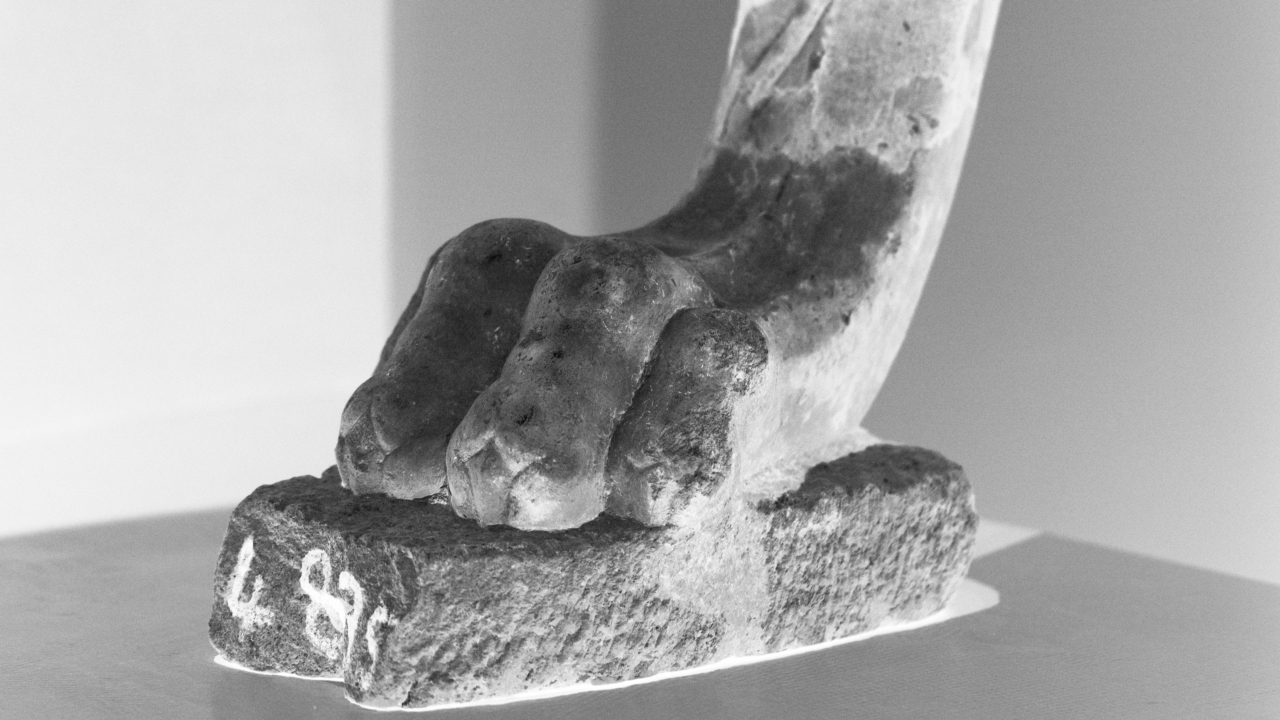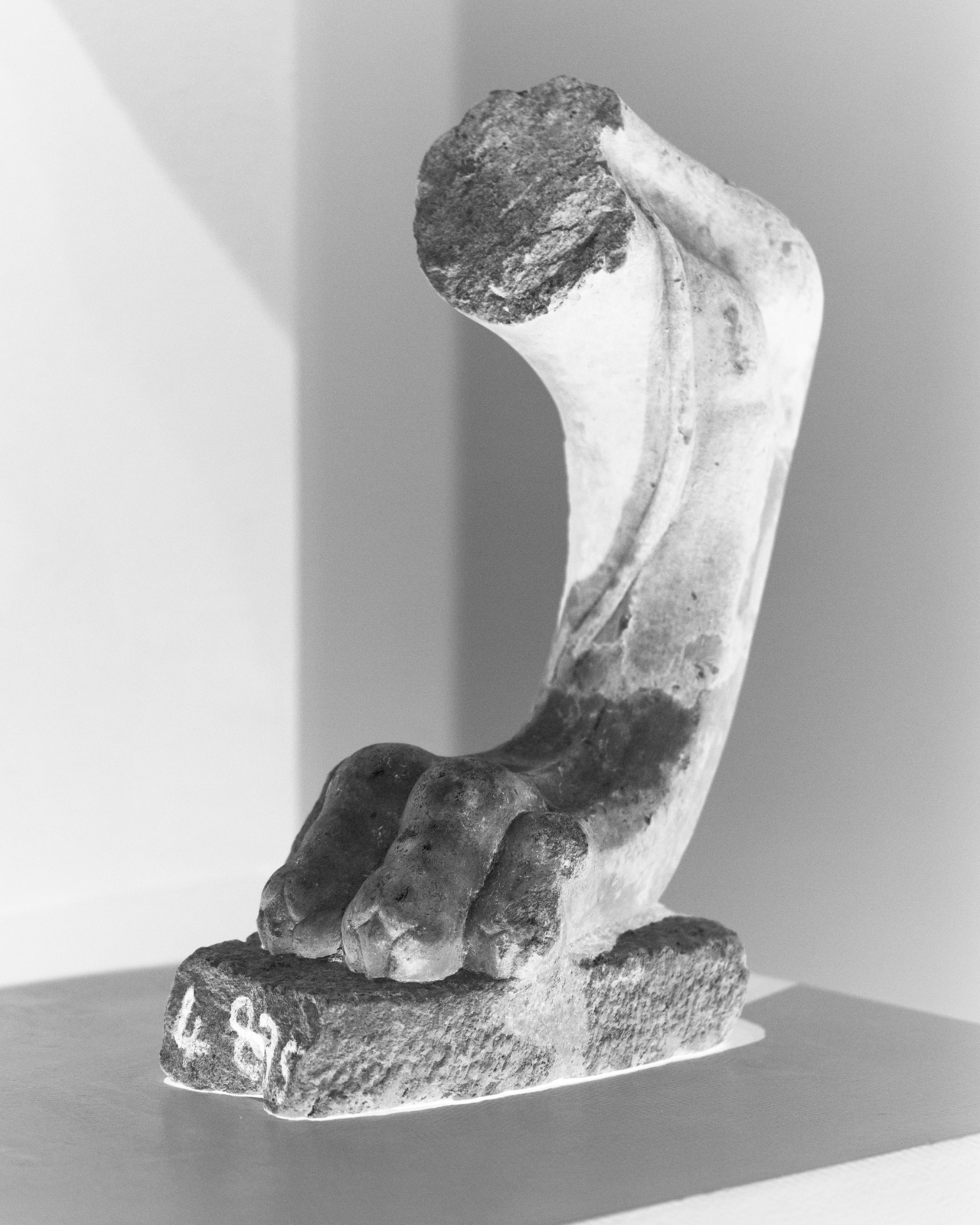

Photograph by Sebastian Mast / Connected Archives
Words by Kyle MacNeill
On a stage in Manchester, England, a gaunt man with impossibly supple limbs arches his arms, thrusting thick, curved horns into the air. He is, in this moment, a Pyrenean ibex. Later, on the same stage, several other performers meticulously move the joints of a reconstructed Asiatic cheetah skeleton, exactingly recreating the big cat’s slinking movement. Dancers become flowers and glaciers with a graceful fluidity. A list of species flicks through on the screen: Bachman’s warbler, Spix’s macaw, Splendid tree frog, and more.
There is not enough time to represent them all. The names begin to rifle through at frenetic speed; the voiceover, who reads out each name, begins to sound like he’s speaking in tongues. These flora and fauna span the entire spectrum of the biosphere, representing nature’s endless—or, more fittingly, ending—variety.
As the show’s title—Figures in Extinction—suggests, all these majestic species are now extinct or critically endangered. It’s the first part of a dance trilogy showing at British art space Factory International from choreographer Crystal Pite, director Simon McBurnery, and Nederlands Dans Theater, which explores the mass loss of life caused by the climate crisis. The space takes on a funereal atmosphere; both audience and performers are collectively grieving creatures we never knew (or, never even knew existed).
But Figures in Extinction is not alone in its mission to highlight the urgency of conservation. Art that represents and reanimates extinct species is becoming increasingly prevalent.
In November, Björk and Aleph Molinari, brought their Nature Manifesto to the Pompidou Centre in Paris, pumping the calls of extinct creatures—their sounds reproduced and distorted by AI—into the building’s escalators. The project aims to revive the biophony, a concept referring to the complex web of calls, decoys, and chants that nature relies upon. “When you remove some of these animals from the biophony, they can’t communicate,” Molinari told Atmos. “Their calls are being substituted by the sounds of machines and urbanism and disrupting animals.”
Similarly, Tasmanian artist Lucienne Rickard has spent the last few years painstakingly penciling incredibly detailed pictures of extinct animals before dramatically erasing them for her project Extinction Studies. “It was an effort to raise awareness of just how poorly we are doing at protecting other life forms,” she said, noting that she considered the discussions sparked by her work to be her greatest success. “The conversations became the most important component of the art. The drawing and erasing was just to hook people into thinking and talking about extinction.”
These projects show that art, like amber, can preserve life before it’s lost forever. But it can also revive it, reimagining creatures from the past—greatly aided by AI, which can turn a passenger pigeon into a phoenix in just a few seconds.
“The loss of these animals is the loss of different possibilities of surviving in the world.”
These works certainly aren’t the first of their kind—Extinction art is technically an ancient practice. Antiquated Amazonian rock art continues to resurface that depicts unknown creatures. And paintings of the cave bear—the first animal thought to have been driven to extinction by humans over 20,000 years ago—are etched onto the walls of the Chauvet cave in France, in blood-red ochre. The cave’s floor itself is still covered in hundreds of skeletons and paw prints, marking the final resting place for many of these creatures. While these artworks were created around 36,500 years ago—long before the cave bear perished—they endured for millennia after, living on for future generations as a document of the past. Life, immortalized in dye.
More recently, however, extinction art has really taken flight, propelled by the rapid decline of species. Extinction itself is a relatively new concept: It was Georges Cuvier, at the turn of the 18th century, who proved that reconstructed elephant fossils were distinct from existing species. Then, following Charles Darwin, much of extinction was understood to be caused by evolution: The survival of the fittest necessitates the demise of the weakest. It’s why over 99% of all species that ever lived on Earth have now died out.
But over the last 100,000 years, human impact can be linked to 96% of the mammal species lost forever. The natural rate of extinction, known as background extinction, is only around one species per million species per year. Humans, though, are speeding up the inevitable by a factor of at least 100.
Consequently, we are now officially living through the sixth mass extinction. Human activity has transformed nearly half of all land for agriculture, driving deforestation and consuming the majority of the planet’s freshwater, in turn wiping out habitats and the species that depend on them. Cuvier’s view of extinction caused by catastrophic events proved to be correct—but it is us, not nature, that are now the architects of this catastrophe. And it’s a butterfly effect. “The loss of these animals is the loss of different possibilities of surviving in the world,” Molinari said.
The rise of extinction art in recent years is part of a bigger movement within visual culture to shine a light on the climate crisis and ignite activism through emotion; to remind us of the irreversibility of our actions. The hope is that these creative projects cut through widespread ignorance. It’s why Figures of Extinction features a Trumpian climate denier, a character mocked for his refusal to face reality. In an age where science paints an alarming picture of biodiversity loss, the persistence of climate denial only amplifies the dissonance and exposes the absurdity of our self-deception.
Reanimating lost species through art is the most powerful way to bring them back to life.
“Extinction art not only memorializes the vanished, it also spotlights the endangered species—of which there are currently around 40,000 and counting—and serves as a rallying cry for action.”
For now, any ambitions of actually resurrecting extinct creatures are just that. Last month, scientists from Colossal, a start-up aiming to recreate the wooly mammoth, introduced the world to genetically-edited “woolly mice.” Colossal’s claim that they are on track to have the first cold-adapted elephant by 2028 seems as realistic as most corporate climate deadlines; and their aim to introduce them to the Arctic to stop permafrost from melting is, ironically, a mere chimera. Ultimately, de-extinction is very much in its infancy—and plagued by ethical and environmental issues.
Artistic representation remains the most viable approach to reanimate the creatures we’ve lost, and nascent technology is allowing us to do this in new ways as with the AI-generated animal calls in Nature Manifesto. Of course, scientific illustrations and photographs of more recently-extinct species can more precisely depict them, but abstract approaches can be just as moving if not more.
There is something undeniably haunting about these artworks. They force us to confront death—not in abstract terms, but through intimate loss of species with distinct personalities. It’s a reckoning with a truth we have long ignored. “People don’t fully connect that these ‘exotic’ animals have a function within the system,” Molinari said. “The more life we have, the richer everything in nature is going to be. But guilt is also a natural reaction, a recognition that we are complicit in their disappearance.
At its strongest, extinction art shatters the reassuring illusion that losing an entire species is unthinkable. Surely, we tell ourselves, they must be protected somewhere—conserved, repopulated or cryogenically frozen? But Figures of Extinction drives home a harsher truth. A poignant leitmotif follows a little girl as she watches a bird disappear into the sky. “Is it gone forever?” she asks.
But this art isn’t just about mourning yesterday; it’s also about tomorrow. After the denial, anger, bargaining, depression, and acceptance comes a resistance. Extinction art not only memorializes the vanished, it also spotlights the endangered species—of which there are currently around 40,000 and counting—and serves as a rallying cry for action.
Does it work? Rickard isn’t sure of the impact of her work. “Art can definitely help us begin to understand extinction,” she said. “Although time is something we humans struggle with, so we’re perhaps not fully getting just how much of a mess we’re making and how long it will take to recover.” Even so, she continues. “I keep going with this focus for my artwork not because I’m convinced it’s working, but because I feel a need to witness and record what we are doing to the planet.”
Molinari is more optimistic. “The message is there’s an emergency that needs to be attended to and that we can’t be nostalgic of the past, but rather we have to see new ways of saving biodiversity,” he said. Perhaps, artworks like Nature’s Manifesto and performances like Figures in Extinction can inspire us to choreograph new ways to protect endangered species—and to prevent a future without our most vital life forms.
The Art of De-Extinction: Reanimating Species We’ve Lost